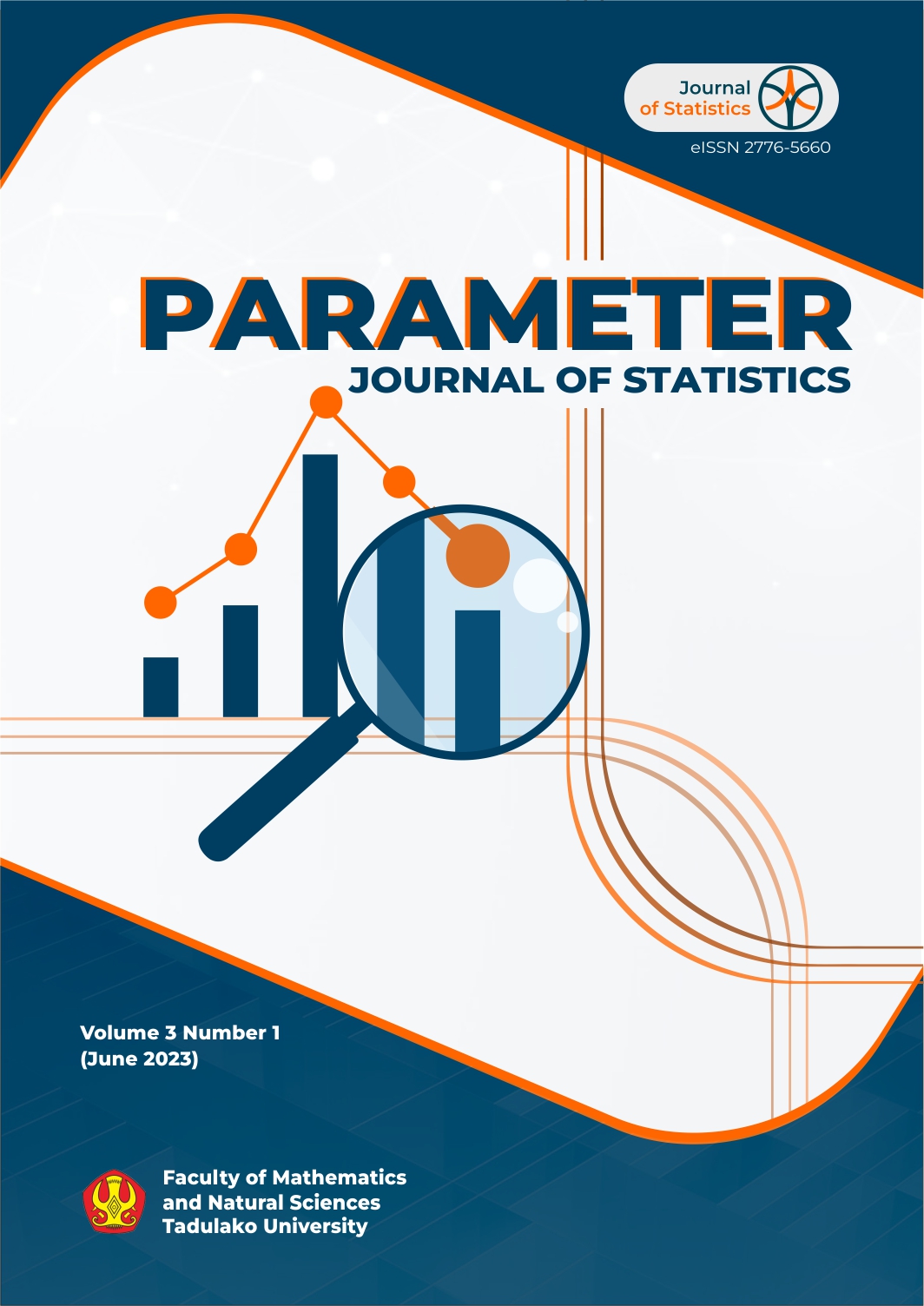Main Article Content
Abstract
Unemployment is a labor problem that is often faced by developing countries like Indonesia. The number of unemployed in Indonesia has fluctuated from year to year, including in Central Java Province. One of the efforts made to overcome this problem is to know the factors that influence unemployment. The region effect greatly affects the open unemployment rate. Modeling involving area effects is very precise, one of which is the Spatial Durbin Model (SDM). In this study, modeling of the open unemployment rate was carried out using a spatial approach in each district/city in Central Java. The models used in this study are Ordinary Last Square (OLS), Spatial Auto Regressive (SAR), Spatial Error Models (SEM), Spatial Durbin Model (SDM), Spatial Error Durbin Model (SDEM). The five methods were evaluated using the Akaike Information Criteria (AIC). The spatial weighting used in this study is Queen Contiguity. Based on the smallest AIC value (115.42), the best method in this study is HR. Meanwhile, the significant factors are the percentage of labor force participation rate (X1), the number of poor people (X4), the lag of economic growth, the lag of poverty, and the lag of the district/city minimum wage
Keywords
Article Details

This work is licensed under a Creative Commons Attribution-ShareAlike 4.0 International License.
References
- Akaike, H. (1998). A Bayesian Analysis of the Minimum AIC Procedure. In E. Parzen, K. Tanabe, & G. Kitagawa (Eds.), Selected Papers of Hirotugu Akaike (pp. 275–280). Springer New York. https://doi.org/10.1007/978-1-4612-1694-0_21
- Chen, H., Yi, J., Chen, A., Peng, D., & Yang, J. (2023). Green technology innovation and CO2 emission in China: Evidence from a spatial-temporal analysis and a nonlinear spatial durbin model. Energy Policy, 172, 113338. https://doi.org/https://doi.org/10.1016/j.enpol.2022.113338
- Chen, Y., Shao, S., Fan, M., Tian, Z., & Yang, L. (2022). One man’s loss is another’s gain: Does clean energy development reduce CO2 emissions in China? Evidence based on the spatial Durbin model. Energy Economics, 107, 105852. https://doi.org/https://doi.org/10.1016/j.eneco.2022.105852
- Du, M., & Ren, S. (2023). Does the digital economy promote industrial green transformation? Evidence from spatial Durbin model. Journal of Information Economics, 1(1), 1–17. https://doi.org/10.58567/jie01010001
- Feng, Z., & Chen, W. (2018). Environmental regulation, green innovation, and industrial green development: An empirical analysis based on the spatial Durbin model. Sustainability (Switzerland), 10(1). https://doi.org/10.3390/su10010223
- Guo, Q., Dong, Y., Feng, B., & Zhang, H. (2023). Can green finance development promote total-factor energy efficiency? Empirical evidence from China based on a spatial Durbin model. Energy Policy, 177, 113523. https://doi.org/https://doi.org/10.1016/j.enpol.2023.113523
- Hiller, A. (2023). Comment on Gignac and Zajenkowski, “The Dunning-Kruger effect is (mostly) a statistical artefact: Valid approaches to testing the hypothesis with individual differences data.†Intelligence, 97, 101732. https://doi.org/https://doi.org/10.1016/j.intell.2023.101732
- Imsar. (2018). Analisis Faktor-Faktor Yang Mempengaruhi Tingkat Pengangguran Terbuka Di Indonesia Periode 1989-2016. HUMAN FALAH, 5(1), 145–164.
- Kamran, A., Shujaat, S., Syed, N. A., & Ali, S. N. (2014). A Study on Determinants of Unemployment in Pakistan. In J. Xu, J. A. Fry, B. Lev, & A. Hajiyev (Eds.), Proceedings of the Seventh International Conference on Management Science and Engineering Management (pp. 1337–1348). Springer Berlin Heidelberg.
- Kelejian, H. H., & Prucha, I. R. (2010). Spatial models with spatially lagged dependent variables and incomplete data. Journal of Geographical Systems, 12(3), 241–257. https://doi.org/10.1007/s10109-010-0109-5
- Kilmer, J. T., & RodrÃguez, R. L. (2017). Ordinary least squares regression is indicated for studies of allometry. Journal of Evolutionary Biology, 30(1), 4–12. https://doi.org/https://doi.org/10.1111/jeb.12986
- Mariani, S., Wardono, Masrukan, & Fauzi, F. (2017). The arcview and GeoDa application in optimization of spatial regression estimate. Journal of Theoretical and Applied Information Technology, 95(6).
- Miller, J., Franklin, J., & Aspinall, R. (2007). Incorporating spatial dependence in predictive vegetation models. Ecological Modelling, 202(3), 225–242. https://doi.org/https://doi.org/10.1016/j.ecolmodel.2006.12.012
- Puspadjuita, E. A. R. (2017). Factors that Influence the Rate of Unemployment in Indonesia. International Journal of Economics and Finance, 10(1), 140. https://doi.org/10.5539/ijef.v10n1p140
- Putri Andayani Suaib, T. (2022). PENERAPAN SPATIAL DURBIN MODEL (SDM) PADA INDEKS PEMBANGUNAN GENDER DI PULAU SULAWESI. Majalah Ilmiah Matematika Dan Statistika, 22(2), 82–95. https://jurnal.unej.ac.id/index.php/MIMS/index
- Septiawan, A. R., Handajani, S. S., & Martini, T. S. (2018). Spatial durbin error model for human development index in Province of Central Java. Journal of Physics: Conference Series, 1025(1). https://doi.org/10.1088/1742-6596/1025/1/012107
- Wang, H., Cui, H., & Zhao, Q. (2021). Effect of green technology innovation on green total factor productivity in China: Evidence from spatial durbin model analysis. Journal of Cleaner Production, 288, 125624. https://doi.org/https://doi.org/10.1016/j.jclepro.2020.125624.
